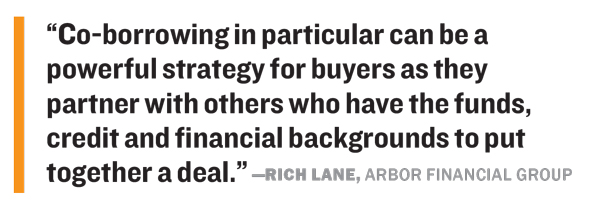Trending
Making a mortgage marriage

As brokers and homebuyers well know, 20 percent is the magic number when it comes to getting financing for a home. Being able to make a 20 percent down payment of the purchase price means not only borrowing less, but also avoiding mortgage insurance, which can cost hundreds of dollars a month. For an increasing number of borrowers in Los Angeles, buying property now means including a co-borrower in the equation.
The increased availability of home-equity sharing programs, which can be either privately or publicly funded, has made co-borrowing more popular across L.A. County over the past two years. And the fast rising median home price in the region could mean that much more co-borrowing is in the offing.
Median home prices in the second quarter grew at a faster annual pace than average weekly wages in Los Angeles County, according to the Q2 2017 U.S. Home Affordability Index curated by ATTOM Data Solutions. The median home sale price in L.A. County reached $569,000 in the second quarter of 2017, up from $550,000 at the start of the year, according to CoreLogic. These prices translate into a 20 percent down payment of more than $110,000, a number that is out of reach for cash-strapped homebuyers.
So, how does co-borrowing work? Let’s say a buyer decides to purchase a $700,000 single-family home. That buyer asks a family member or friend — the co-borrower — to put up the 20 percent down payment in exchange for 20 percent ownership in the property. The co-borrower also has the benefit of being able to write off her 20 percent of the mortgage, property taxes, insurance and related fees, such as repairs. And, in some cases, the co-borrower can receive rent from the buyer for the duration of the loan, according to the percentage of square feet in which she invested. When the property is sold, the profit or loss is divided by the same formula: 80 percent to the main buyer and 20 percent to the party who put up the down payment.
Currently, co-borrowing and other unconventional lending scenarios make up a relatively small percentage of all L.A. area residential lending, said Rich Lane, a Los Angeles-based mortgage broker with Arbor Financial Group. But brokers familiar with shared equity deals in L.A. expect the concept to increase in popularity as real estate once again becomes an attractive way to seek financial stability.
“I think people have identified that owning a home for their primary residence, and in many instances a rental home as well, is a solid path to building wealth,” Lane said. “People in L.A. have realized that real estate moves in cycles, but always comes back.”
In the second quarter, 22.8 percent of mortgage purchase applications in the U.S. involved a co-borrower, according to a new report from ATTOM Data. That’s up from 21.3 percent in the prior quarter and 20.5 percent a year ago, as previously reported by The Real Deal.
“We see the unconventional scenarios occur mostly when people are buying investment homes to fix and flip or to buy/hold as a rental,” Lane said. “This financing occurs mostly from regional portfolio lenders that are using private institutional funds and not traditional ‘big-box’ banks.”
 While flipping houses was once a frenzied activity in Southern California, since 2011, it’s down nearly 20 percent, to about 11,000 home flips in 2016, the latest year for which data is available from ATTOM. The reason? Those who purchase homes with the intent of remodeling and selling them for a profit within a year are being priced out of Los Angeles, Orange, Riverside and San Bernardino counties. As a result, they’re searching further inland for projects or seeking more creative ways to finance investment homes, such as co-borrowing, said Lane.
While flipping houses was once a frenzied activity in Southern California, since 2011, it’s down nearly 20 percent, to about 11,000 home flips in 2016, the latest year for which data is available from ATTOM. The reason? Those who purchase homes with the intent of remodeling and selling them for a profit within a year are being priced out of Los Angeles, Orange, Riverside and San Bernardino counties. As a result, they’re searching further inland for projects or seeking more creative ways to finance investment homes, such as co-borrowing, said Lane.
“Co-borrowing in particular can be a powerful strategy for buyers as they partner with others who have the funds, credit and financial backgrounds to put together a deal,” he said. “These unconventional mortgages are an amazing conduit to get people into real estate investing that otherwise simply couldn’t with the traditional programs that the big banks offer.”
Co-borrowing options, whether for buy-fix-and-flip investors or individuals, can originate from both private and government-backed lenders — but there are some important differences between the two.
Mortgage credit certificates (MCC), a form of government equity sharing, mean borrowers are aided by local governments and may receive down payment assistance, lower interest rates or the ability to use a portion of the mortgage as a tax credit. And, according to industry experts, because governments typically have high credit ratings, they can pass along lower mortgage rates to buyers.
These are attractive advantages, but these same benefits can make it more difficult to reap the equity in residential properties that comes with time and rising values. If an MCC buyer sells the house within the first nine years after purchasing it, the government can be entitled to 50 percent of any appreciation, or about 6 percent of the total loan amount, whichever is less.
San Francisco’s Downpayment Assistance Loan Program, for example, is a municipal-backed plan that matches private companies with buyers who need help with down payments in exchange for a share of a home’s equity, usually no more than 30 percent. Unlike most co-borrower loans of this type, qualified first-time buyers can get a deferred payment loan of up to $375,000, then make no monthly payments on it for three decades. However, the amount they borrowed, plus a share of the home’s equity, must be paid after 30 years or whenever the home is sold.
Los Angeles has a Low Income Purchase Assistance program for first-time income-eligible buyers who can receive down payment loans up to $90,000 that don’t accrue interest or require monthly payments. Instead, the City of Los Angeles earns equity in the home as it appreciates. To be eligible for this program, a family of four must earn less than $69,450.
As of the mid-year mark, the Los Angeles City Council planned to bring back a similar loan program for first-time middle-income buyers who earn less than $130,000 for a family of four.
This program would allow the homeowner to forgo interest and monthly payments and instead give the city a percentage of the home’s equity as it
appreciates.




